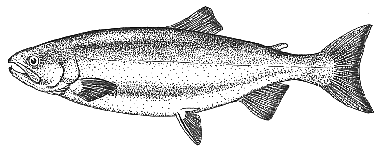
A Fisherman Looks at Chum Salmon
with
D.C. Reid
illustrations by Barb Krimmer
Vying with
coho
for the title of second largest species of Pacific salmon,
chum
reach adult weights exceeding 20 pounds. Adult fish typically spawn within a few miles of the ocean in one of the 900 short coastal streams of British Columbia. A few strains do, however, migrate long distances up major rivers. Yukon River chum, for instance, return to the same one hundred yard stretch of gravel 2,000 kilometers from the ocean.
Although normally found in small coastal streams, chum, like other salmon perform great feats of physical effort in reaching their mating waters. During ocean migration, salmon travel distances as great as 35 miles per day, and, once in their home river, may swim over 10 miles upstream each day. A flick of the tail and a salmon erupts from the water at 14 miles per hour.
Females lay 2,000 - 4,000 eggs in stream bed redds during the November to January period. Hatching as yolk-dependent alevins two months later, young chum remain within the gravel until emerging as fry in spring. At this time chum migrate immediately to the ocean and rear in calm bays in May and June. Schools of two inch chum roam the smooth waters hazing the surface with the splash of their delicate bodies. This jumping behaviour distinguishes them from many other newly-hatched fish species, herring, for instance, which tend to stay deeper in the and produce jags of light as they spiral one after the other, much like a night sky of stars.

Chum smolts migrate north along the coast toward Alaska at a rate of 3 - 16 miles per day, intermingling with young sockeye and pink. These species move north in close proximity to the coast. This contrasts with chinook and coho which spread out from the coastal belt to well offshore during their outward migration. All species then fan out across vast areas of the North Pacific.
After spending their adult lives in the open ocean, chum return to as 3 - 5 year old fish. Thus some cross-fertilization from one year to the next is observed, a decided advantage for preservation of the species. As with the other migratory salmon, it is rare to catch a chum under the 12 inch (30 cm) size restriction limit. Indeed it is rare to catch one at all. Plankton feeders by nature, living off jellyfish and minute crustaceans, chum very rarely bite on sport fishing lures. In 1996, for example, while the commercial fleet harvested over 1,344,000 chum, only 682 were caught by sports fishers.
While managing to evade the sports fisher, chum do their best to annoy them. During October, schools of hundreds and thousands ripen in saltwater bays close to estuaries. Here they perform a characteristic behaviour known to all
west coast
fishers. Chum swim in tight schools absolutely on the surface, erupting here, there and everywhere. Chum salmon launch themselves almost horizontally from the water, invariably falling lazily on their sides. The first leap is followed by another and then another until an individual fish has completed six to eight jumps, the line of which describes a gentle curve across the sea. Imagine the sea alive with purple- and yellow- barred salmon, none of which will bite a lure.
Shortly after their aerial displays, chum can be found on the spawning beds often within sight of the ocean. Here they present a macabre sight. As soon as they enter fresh water - even prior to spawning - chum salmon begin to disintegrate. Their once silvery bodies become covered with yellow and black patches, flesh begins to fall from their bones. It is a sad sight to witness seagulls sittting on their backs in the soft forest rain, pecking out the eyes of dying fish.
Occasionally, though, a fisher will intercept a chum in the ocean. On rare occasions chum will bite an anchovy, perhaps out of pre-spawning irritation. Alternatively, the anchovy may resemble an egg-loving cutthroat trout and the chum salmon snaps at it in order to protect its eggs.
Prior to taking on their alternating bars of colour and the hooked jaw that gives them their nickname "dog salmon", chum are quite silver fish. Their tails bear no black spots, however, fine black speckling may be present on dorsal surfaces. Ventral fins - pectoral, anal and caudal - have dark tips and the waist, or anal peduncle, is slender. Gill rakers are stubby, smooth, widely spaced and 19 - 25 in number.
The fisher need not lose complete hope of catching chum on their migratory dash. Sockeye were also a non-sport caught salmon before the 1980s. At that point in time, for a reason that is not understood, sockeye began taking slowly trolled lures. It is always possible that this will occur with chum as well. The inventiveness shown by manufacturers in developing lures for other species may also ultimately result in a line of lures specifically developed for chum. The pattern may prove to be small and clear with a tinge of red; chum eat plankton, the predominant colours of which are pink with bits of black on a clear background.
More information on Chum Salmon & other
Game Fish
of B.C.
|




